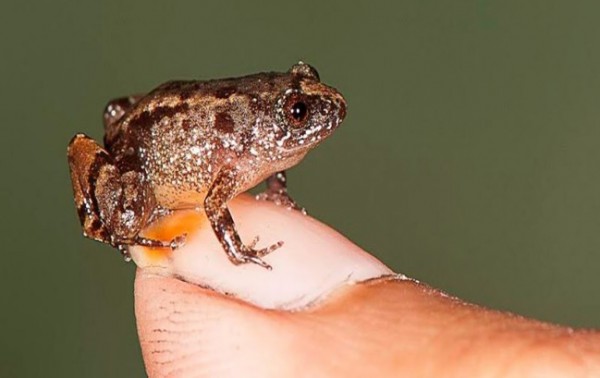By Ana Verayo, | February 22, 2017

Newly discovered miniature frog species in India measures 0.5 inches. (Sd Biju/University of Delhi)
Scientists have discovered some of the smallest frog species in India. During the course of a five-year survey, scientists were able to uncover seven previously unknown "night frogs." Four of them are so tiny that one can comfortably sit on your fingertip.
These night frogs originate from the Nyctibatrachus genus, and are apparently abundant in the survey area. Scientists say that they were undetectable at first due to their minuscule size and their croaking sounds like insects chirping.
Like Us on Facebook
To date, there are now 35 night frog species in total. Several of them are classified as miniaturized, measuring smaller than 0.7 inches. The smallest of these newly found frogs are around 0.5 to 0.6 inches which are the Nyctibatrachus manalari, Nyctibatrachus pulivijayani, Nyctibatrachus robinmoorei, and the Nyctibatrachus sabarimalai. The others are slightly larger with the Nyctibatrachus webilla at 0.7 inches and the Nyctibatrachus athirappillyensis at 0.8 inches. The largest among the newly discovered mini frogs is the Nyctibatrachus radcliffei measuring at 1.5 inches.
This type of frogs thrive in the Western Ghats mountain range in India's western coast and spanning 54,054 square miles. It is also considered as one of the world's richest biodiversity hotspots and is also a UNESCO (United Nations Educational, Scientific and Cultural Organization) World Heritage Site.
This is a precious habitat for hundreds of unique animal and plant species that are also listed as threatened. More specifically, 145 species are considered as endangered and 51 species are critically endangered.
According to the co-author of the study, biologist SD Biju from the Systematics Lab with the Department of Environmental Studies of the University of Delhi in India, more than 32 percent of Western Ghats frogs are now threatened with extinction. Biju added that five out of the seven new species we discovered are now facing anthropogenic threats and require immediate priority for conservation.
This new study was published in the journal PeerJ.
-
Use of Coronavirus Pandemic Drones Raises Privacy Concerns: Drones Spread Fear, Local Officials Say

-
Coronavirus Hampers The Delivery Of Lockheed Martin F-35 Stealth Fighters For 2020

-
Instagram Speeds Up Plans to Add Account Memorialization Feature Due to COVID-19 Deaths

-
NASA: Perseverance Plans to Bring 'Mars Rock' to Earth in 2031

-
600 Dead And 3,000 In The Hospital as Iranians Believed Drinking High-Concentrations of Alcohol Can Cure The Coronavirus

-
600 Dead And 3,000 In The Hospital as Iranians Believed Drinking High-Concentrations of Alcohol Can Cure The Coronavirus

-
COVID-19: Doctors, Nurses Use Virtual Reality to Learn New Skills in Treating Coronavirus Patients







